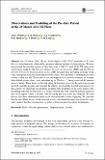Files in this item
Observations and modelling of the pre-flare period of the 29 March 2014 X1 flare
Item metadata
| dc.contributor.author | Woods, M. M. | |
| dc.contributor.author | Harra, L. K. | |
| dc.contributor.author | Matthews, S. A. | |
| dc.contributor.author | Mackay, D. H. | |
| dc.contributor.author | Dacie, S. | |
| dc.contributor.author | Long, D. M. | |
| dc.date.accessioned | 2017-02-14T17:30:19Z | |
| dc.date.available | 2017-02-14T17:30:19Z | |
| dc.date.issued | 2017-02 | |
| dc.identifier.citation | Woods , M M , Harra , L K , Matthews , S A , Mackay , D H , Dacie , S & Long , D M 2017 , ' Observations and modelling of the pre-flare period of the 29 March 2014 X1 flare ' , Solar Physics , vol. 292 , 38 . https://doi.org/10.1007/s11207-017-1064-9 | en |
| dc.identifier.issn | 0038-0938 | |
| dc.identifier.other | PURE: 249001090 | |
| dc.identifier.other | PURE UUID: 23649571-b9c9-45a2-a854-697e3a04c223 | |
| dc.identifier.other | ArXiv: http://arxiv.org/abs/1701.06457v1 | |
| dc.identifier.other | Scopus: 85013083647 | |
| dc.identifier.other | ORCID: /0000-0001-6065-8531/work/58055416 | |
| dc.identifier.other | WOS: 000395398700014 | |
| dc.identifier.uri | https://hdl.handle.net/10023/10298 | |
| dc.description | MMW and SD acknowledge STFC for support via their PhD Studentships. DML is an Early-Career Fellow, funded by the Leverhulme Trust. | en |
| dc.description.abstract | On the 29 March 2014 NOAA active region (AR) 12017 produced an X1 flare which was simultaneously observed by an unprecedented number of observatories. We have investigated the pre-flare period of this flare from 14:00 UT until 19:00 UT using joint observations made by the Interface Region Imaging Spectrometer (IRIS) and the Hinode Extreme Ultraviolet Imaging Spectrometer (EIS). Spectral lines providing coverage of the solar atmosphere from chromosphere to the corona were analysed to investigate pre-flare activity within the AR. The results of the investigation have revealed evidence of strongly blue-shifted plasma flows, with velocities up to 200 km-1, being observed 40 minutes prior to flaring. These flows are located along the filament present in the active region and are both spatially discrete and transient. In order to constrain the possible explanations for this activity, we undertake non-potential magnetic field modelling of the active region. This modelling indicates the existence of a weakly twisted flux rope along the polarity inversion line in the region where a filament and the strong pre-flare flows are observed. We then discuss how these observations relate to the current models of flare triggering. We conclude that the most likely drivers of the observed activity are internal reconnection in the flux rope, early onset of the flare reconnection, or tether cutting reconnection along the filament. | |
| dc.format.extent | 24 | |
| dc.language.iso | eng | |
| dc.relation.ispartof | Solar Physics | en |
| dc.rights | © The Author(s) 2017. Open Access. This article is distributed under the terms of the Creative Commons Attribution 4.0 International License (http://creativecommons.org/licenses/by/4.0/), which permits unrestricted use, distribution, and reproduction in any medium, provided you give appropriate credit to the original author(s) and the source, provide a link to the Creative Commons license, and indicate if changes were made. | en |
| dc.subject | Flares | en |
| dc.subject | Pre-flare phenomena | en |
| dc.subject | Magnetic fields | en |
| dc.subject | Models | en |
| dc.subject | QB Astronomy | en |
| dc.subject | QC Physics | en |
| dc.subject | NDAS | en |
| dc.subject.lcc | QB | en |
| dc.subject.lcc | QC | en |
| dc.title | Observations and modelling of the pre-flare period of the 29 March 2014 X1 flare | en |
| dc.type | Journal article | en |
| dc.contributor.sponsor | Science & Technology Facilities Council | en |
| dc.contributor.sponsor | Science & Technology Facilities Council | en |
| dc.contributor.sponsor | The Leverhulme Trust | en |
| dc.description.version | Publisher PDF | en |
| dc.contributor.institution | University of St Andrews. Applied Mathematics | en |
| dc.identifier.doi | https://doi.org/10.1007/s11207-017-1064-9 | |
| dc.description.status | Peer reviewed | en |
| dc.identifier.grantnumber | ST/K000950/1 | en |
| dc.identifier.grantnumber | ST/N000609/1 | en |
| dc.identifier.grantnumber | IN-2014-016 | en |
This item appears in the following Collection(s)
Items in the St Andrews Research Repository are protected by copyright, with all rights reserved, unless otherwise indicated.

